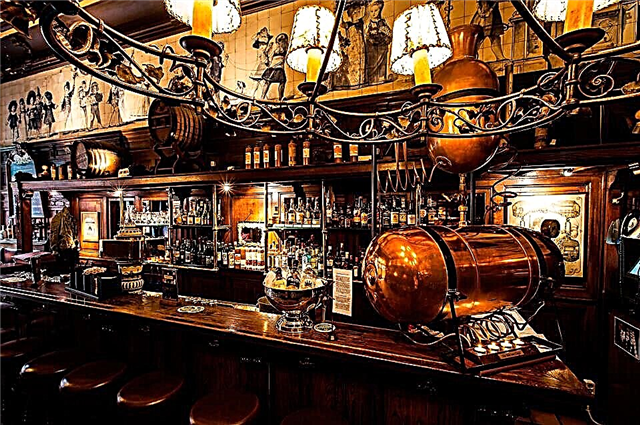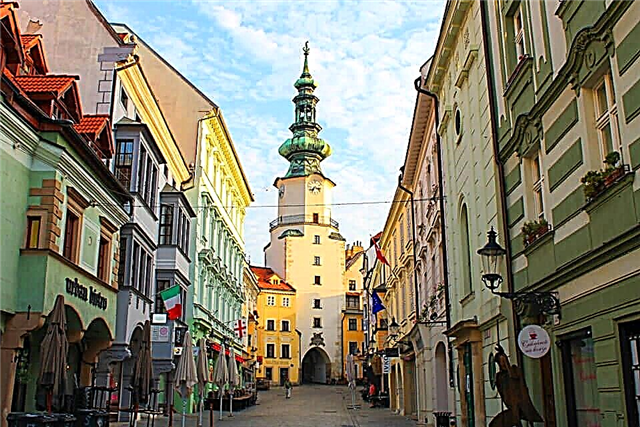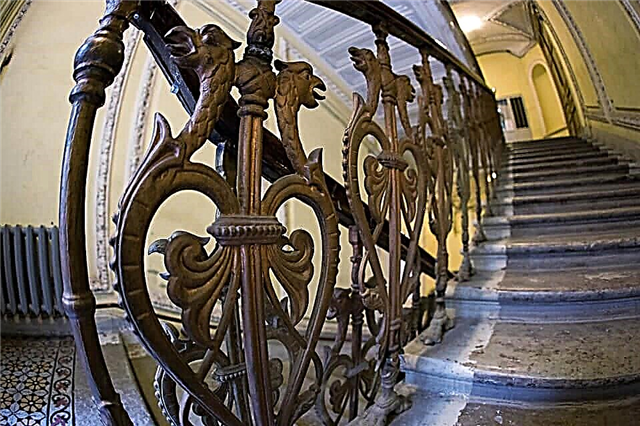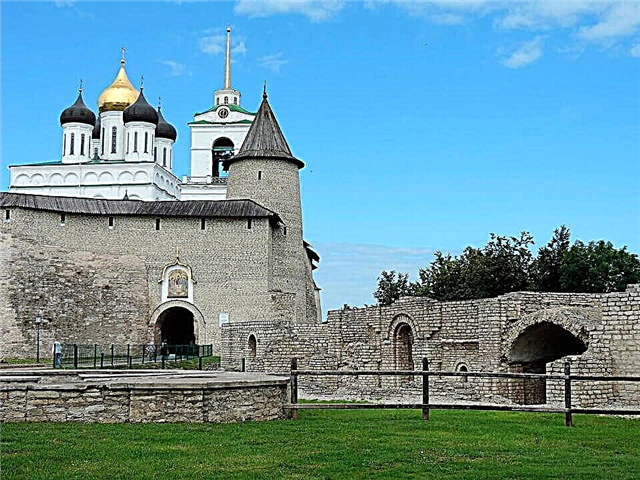The name of Fyodor Mikhailovich Dostoevsky is known in many countries of the world, and his works have been translated into different languages. Readers and literary critics argue about the novels of the great writer, they are filmed and put on the stage. Dostoevsky entered the history of Russia so firmly that even the places where his literary heroes lived became landmarks.
F. Dostoevsky Museum-Apartment in Moscow

Living room in the F. Dostoevsky museum-apartment in Moscow
The memorial museum operates in the northern wing of the former Mariinsky hospital on Bozhedomka. The building is notable for the fact that it has never been rebuilt. Solid walls, ceilings and stoves look exactly the same as during Dostoevsky's life. Authentic interiors were recreated thanks to the memoirs of the writer's younger brother, Andrey.
It is very interesting to visit the apartment where the future author of "The Brothers Karamazov" spent his childhood! You will see portraits of Dostoevsky's parents, a writing desk, glasses, ink utensils, a box of cigarette cartridges, business cards, and other personal belongings and furnishings that the writer used.
The estate of F. Dostoevsky in the village of Darovoe

View of the wing in the estate of F. Dostoevsky in Darovoe
In 1827, Dostoevsky's father Mikhail Andreevich received the right to hereditary nobility and three years later bought a small estate 150 km from Moscow... Thanks to his childhood in the village, little Fedor was able to get acquainted with the life of serf Russia.
A museum complex and a picturesque natural landscape reserve in Darovoye appeared in 2011. Tourists are allowed to visit the linden park, Fedina grove and the entrance alley freely during the day. Except for the outbuilding, all the old manor buildings have been lost. Excavations were carried out on the site of the former buildings of the noble estate, and archaeologists have discovered many interesting finds.
Trinity Izmailovsky Cathedral
Article: Trinity Izmailovsky Cathedral - the revived guards temple

General view of the Trinity Izmailovsky Cathedral in St. Petersburg
Orthodox church in the Admiralteysky district St. Petersburg appeared in the 30s of the XIX century. The stone cathedral was built by the talented architect Vasily Petrovich Stasov on the site of an old wooden church. In 1867, under the arches of this church, the wedding of Fyodor Dostoevsky and Anna Snitkina took place.
In the 1930s, the temple was closed. At first, they wanted to demolish the solid building or rebuild it into a city crematorium. During the Great Patriotic War, the church was badly damaged by bombing. Today, the five-domed cruciform cathedral has been completely restored and receives believers and tourists every day.
F. Dostoevsky Literary Memorial Museum in St. Petersburg

F. Dostoevsky's study at the Literary Memorial Museum
In the house 5/2 on Kuznechny lane, the writer rented an apartment twice, so a memorial museum was opened there since 1971. Here Dostoevsky wrote the story "The Double" and chapters of the famous novel "The Brothers Karamazov". Residential interiors were recreated according to the recollections of Dostoevsky's wife and contemporaries.
Tourists pass through the hallway, nursery, wife's room, dining room, living room and Dostoevsky's office. In the place where the writer worked, he rarely received guests. Only close relatives and friends of the writer saw the strict atmosphere of the office. Dostoevsky died in this house, so the calendar clock on the table shows the tragic date - January 28, 1881.
Tobolsk prison castle

View of the Tobolsk prison castle
One of the places associated with Dostoevsky's life is located far from Moscow and St. Petersburg - in the Siberian city of Tobolsk. In 1849, the Military Judicial Commission found Fyodor Mikhailovich guilty and sentenced him to "the death penalty by shooting." Later, the punishment was replaced by hard labor. In 1850, the writer was imprisoned in the Tobolsk prison.
Nowadays, the former convict-transit prison has been turned into a museum. The prison castle complex is located near the Tobolsk Kremlin and consists of five buildings. Tourists are shown prison buildings, a green camp tower, tiny punishment cells, a meeting room, cramped prison cells and exercise yards.
House-Museum of F. Dostoevsky in Staraya Russa

View of the house-museum of F. Dostoevsky in Staraya Russa
The two-storey house is located in one of the most picturesque areas - on the embankment of the Pererytitsa River. The writer lived in Staraya Russa for 8 years. In this city were written the novels "Demons" and "Teenager", articles for the "Diary of a Writer" and the famous Pushkin speech. The collection was started by Dostoevsky's wife. Two years after the death of the writer, she officially announced the opening of the museum.
In a neat wooden mansion, it is easy to feel the atmosphere of the second half of the 19th century and learn about the time of Dostoevsky's life in Staraya Russa. The museum contains personal belongings of the writer's family members, a collection of antique furniture, valuable photographs of the city and the Dostoevsky parish school.
F. Dostoevsky Museum in Novokuznetsk

View of the F. Dostoevsky Literary and Memorial Museum in Novokuznetsk
One of the seven literary museums of the writer is located in Novokuznetsk. Once upon a time there was a house where Fyodor Mikhailovich visited three times in 1856-1867. This period of the life of the genius of world literature is reflected in five exhibitions. The museum tells about Dostoevsky's stay in the city and his wedding with Maria Dmitrievna Isaeva.
The halls display a miniature model of the old Kuznetsk, copies of letters, books and critical works by F. Dostoevsky. Museum staff conduct interesting sightseeing tours of the city for the guests of Southern Kuzbass, tourist routes through the museums of Novokuznetsk and the Kuznetsk Fortress.
F. Dostoevsky Literary Museum in Omsk

View of the F. Dostoevsky Literary Museum in Omsk
The Omsk Museum operates in one of the oldest buildings in the city - the house of the commandants of the Omsk fortress, which was built in 1799. The exposition revealing the work and life of the writer was created in 1983. Dostoevsky spent four long years in the Omsk prison prison.
On the basement floor of the building, the interior of a prison cell from the mid-19th century has been recreated. Visitors are shown shackles, prison clothes, numbers of old literary magazines and lifetime editions of the prose writer. In addition to Dostoevsky, the museum in Omsk is dedicated to the fate of other writers - A.S. Sorokin, R.I. Rozhdestvensky, L.N. Martynov and S.P. Zalygin.
House of Sonya Marmeladova

View of the house of Sonya Marmeladova at the address St. Petersburg, Griboyedov Canal embankment, 73
Tourists who come to St. Petersburg are very popular with excursions to the places described in the works of Dostoevsky. One of the notable buildings is located on the embankment of the Griboyedov Canal, 73. In the novel of the writer, Sonya Marmeladova lived on the embankment of the Catherine Canal.
In the middle of the 19th century, a stone building next to the Fire Station belonged to the Treasury Chamber. In the first years of Soviet power, the provincial institution was abolished, and two more floors were added to the two-story mansion. Today, the house of the heroine of Dostoevsky's novel has a yellow color and strict classical facades.
Raskolnikov's house

View of the Raskolnikov house at St. Petersburg, Grazhdanskaya street, 19
The writer settled the main character of the novel in a tenement house at the intersection of Grazhdanskaya Street and Stolyarny Lane. According to the text of the work, Rodion Raskolnikov rented a room on the 4th floor. The beautiful building was built in 1831 according to the project prepared by the architect Yegor Timofeevich Tsollikofer.
On the wall of the old house you can see memorial plaques in Russian and German, which mark the level of water rise during the flood of 1824.In the corner of the building there is a high relief dedicated to the famous novel by Dostoevsky.
House of the old woman-pawnbroker

View of the house of the old woman-pawnbroker at the address St. Petersburg, Griboyedov Canal Embankment, 104
Residential building on the embankment of the Griboyedov Canal, 104, is not spared by any literary tour of the city. According to researchers of Dostoevsky's work, the heroine of Dostoevsky's novel Alena Ivanovna lived here. The house on a plot with two courtyards was built in 1800. From 1816 to 1818, the famous Russian playwright and diplomat Alexander Sergeevich Griboyedov lived there, and the Decembrists visited him.
The base of the residential building and the frame of the first floors have been preserved since the beginning of the 19th century, while other parts of the house have been reconstructed several times. There is a plaque on the wall about the protection status of the building, but there are no plans to open a museum here yet.
Grushenka's house

View of Grushenka's house at St. Petersburg, Griboyedov Canal Embankment, 25
Another "literary" address is associated with the memorable female image of the heroine of the novel "The Brothers Karamazov" - Agrippina Svetlova. Literary critics believe that Dostoevsky wrote the story of Grushenka from a close friend of his wife, who lived in Staraya Russa.
A two-story bourgeois mansion at 25 Glebova Embankment appeared on the bank of Pererytitsa in the 19th century. Its facade is decorated with a girdle and cornice, and the windows are decorated with carved platbands. Although there is a memorial plaque on the house, the building is in an extremely neglected state and in need of renovation.
Alexander Nevsky Lavra in St. Petersburg
Article: Holy Trinity Alexander Nevsky Lavra: an architectural complex built in memory of the Great Victory in the Battle of the Neva

General view of the Alexander Nevsky Lavra
The male monastery at the eastern end of Nevsky Prospekt is one of the Orthodox shrines of the city on the Neva. The monastery has had the honorary status of a laurel since 1797. Dostoevsky hardly mentioned the St. Petersburg monastery in his works, but fate forever linked it with the Alexander Nevsky Lavra.
The seriously ill writer died at the age of 60 on January 28, 1881. After his death, many people began to come to his apartment to say goodbye to Dostoevsky.

Fyodor Dostoevsky's grave at the Tikhvin cemetery
Three days later, the writer was buried at the Tikhvin cemetery, which is located on the territory of the Alexander Nevsky Lavra. An expressive monument is erected on the grave, and there are always fresh flowers.











